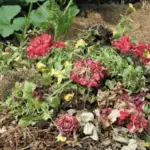Composting in winter season? The answer is yes. You can keep composting in the winter by following a few simple steps.
When you think of composting, warm, sunny weather usually comes to mind. The heat from the sun helps keep the pile’s internal temperatures high. Without heat and oxygen, the decomposition process slows to a crawl.

Should You Compost in the Winter?
It makes sense to keep your compost pile going throughout the year. You always have kitchen scraps and yard waste. Tossing the items in the trash is a waste. The items may decompose in the landfill, but a better use is in your garden.
Winter composting ensures you are ready to fertilize your lawn and garden plants in the spring.
If you wait to start composting until the weather warms up, you may have to rely on store brought fertilizers for a few months.
It takes the materials in compost several weeks or months to decompose and your plants can’t wait that long for feeding.

How to Compost in the Winter
Winter composting is easy. The major difference is the outside temperature. Depending on your average temperatures, running out to the compost may require everything from boots to a heavy coat.
One tip is to have an indoor storage bucket. Look for one with a lid. You can temporarily store kitchen waste, reducing the number of trips you make outside. The lid helps keep the odors in and out of the house.
If you are wondering what can you compost in the winter, the answer is the same as in the spring and summer. Your yard waste, kitchen scraps, and coffee grounds can all go in winter compost.
Don’t forget about the cardboard boxes from Christmas. Most cardboard is also compostable.
Don’t Winter Compost These Items
Some items you want to move to the recycling pile in the winter. The colder temperatures slow the decomposition process too much for some waste to be ready for spring use.
Do not compost your live Christmas tree. There are recycling facilities and organizations that accept the trees. You also want to avoid tossing branches larger than 1/4" in diameter. Run these larger twigs through a wood chipper.
Check the Acidity to Carbon Ratio
A healthy compost pile is one with a 30 to 1 ratio of carbon and nitrogen. If you aren’t sure of your ratio, the University of Missouri has a free chart you can use.
The green layers in compost produce nitrogen, while the brown ones are responsible for carbon. Grass clippings and other plant waste provide nitrogen, while coffee grounds, twigs, and wood pulp take care of the carbon.
Plants require both nutrients to support healthy spring and summer growth.
Pay Attention to Compost Pile Size
Heat is necessary for decomposition and it’s harder to maintain a warm internal temperature in the winter. It’s why you need to pay attention to the size of your compost pile.
Aim for a pile about three or four feet deep on the sides. Keep the overall height the same. These measurements help trap and generate heat while also allowing for airflow. Oxygen is as crucial as heat for decomposition.
You always want to alternate the layers in the pile, going from brown to green or vice versa. Go ahead and moisten the new layers. It will help activate decomposition.
If you are worried about odors, a light layer of topsoil will help absorb smells.
Insulate Winter Compost
Microbes in your winter compost pile break down the material, and the organisms need heat to survive. Cold internal temperatures will make your compost inactive.
The layers will eventually break down, but the compost won’t be ready by spring. You also have to deal with the odors that come from slowly rotting compost.
There are a few ways you can keep the pile warm. If the pile is in a sunny location, you have an edge. Even a winter sun provides some heat, and it might be enough if your compost pile is around three to four feet thick.
Another way to insulate winter compost piles is with layers of straw, cardboard, leaves, and sawdust. These materials add heat, along with essential carbon.
Use Worms in Winter Compost
Earthworms are a gardener’s best friend and a great addition to winter compost piles. Worms break down your kitchen waste, turning it into rich soil.
Not everyone can add worms to compost in the winter. It depends on how cold the temperature drops.
In areas where winter temperatures average between 40-80 degrees Fahrenheit, the worms will thrive in the compost.

Winter Composting Indoors
Below freezing temperatures are common in some regions during the winter, and it can make it difficult to keep a compost pile going. Have you considered indoor composting?
It’s a convenient way to keep composting all year.
You also aren’t stuck using one indoor composting method, you have options to fit any home or apartment.
- Sealed, insulated container: Using a sealed and insulated container keeps odors locked in during decomposition. You can stick the container out of the way in a garage corner or kitchen closet.
- Worm composting: Not everyone is comfortable keeping worms in their home, but it is an extremely effective way to compost throughout the year. You can find worm composting kits online and at some garden and home improvement stores.
- Food waste digester: A food waste digester is a convenient and inexpensive countertop appliance. With the press of a button, the appliance chops, dices, and dehydrates food scraps, turning the waste into useable, nutrient-rich fertilizer. You can store the dehydrated bits in a sealed bag or bucket until you are ready to use the waste in the spring.

Conclusion
You can compost in the winter. It ensures you are ready to start fertilizing in the spring and reduces the amount of waste going to landfills.
Remember to keep the pile’s internal temperature up. You also want to balance the amount of nitrogen and carbon-rich items you add to the pile.






